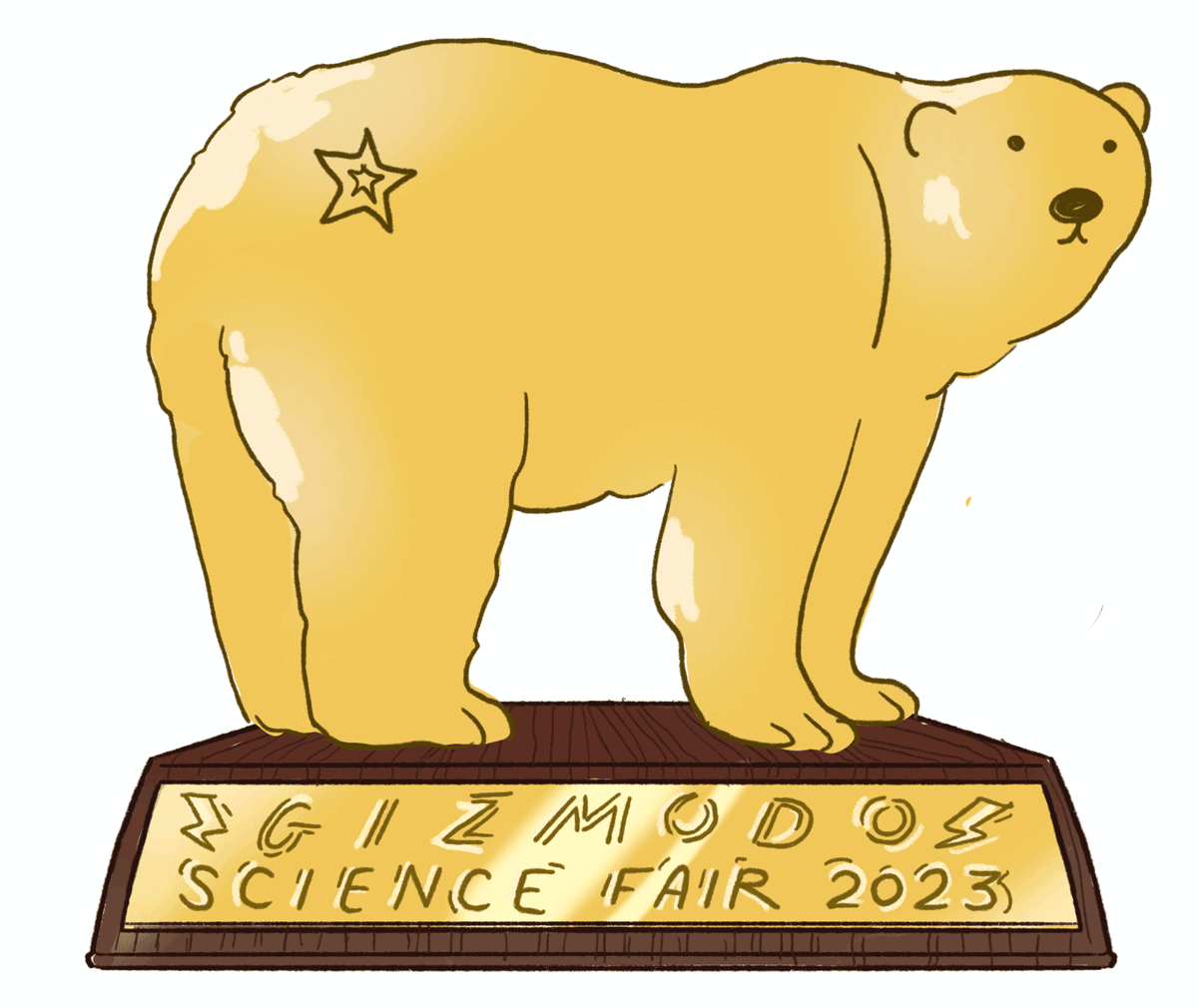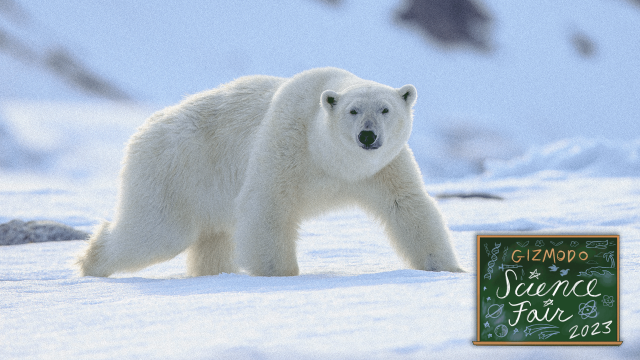Researchers at Polar Bears International, York University, and 3M are winners of the 2023 Gizmodo Science Fair for developing a burr-like tracking device that sticks to polar bears’ fur.
The Question
Is there a better way to track polar bears in the Arctic, that avoids the problems with collars and ear tags?
The Results
A team of researchers from Polar Bears International, 3M, York University, and participating zoos worked to create a polar bear tracking device that could be safely attached to most polar bears. They thought of how burrs stick to animal fur, hanging on even as the animal travels great distances. They began to develop “burr on fur,” a tracker that is placed onto the fur at the back of the bear’s neck. The best time to place these trackers is in the fall, when that fluffy white fur is becoming thicker in preparation for winter.
Finding the right design was a challenge. They created several attachment prototypes, which they tested on faux fur and real bears. One is shaped like a pentagon, with a tracker box on a small platform. The fur is pulled through copper tubes, which researchers then crimp to hold the fur in place. Another is the tri-brush attachment, which looks like a metal triangle with strong pipe-cleaner like brushes on each side that tangle into the bear’s fur. Other prototypes have included adhesives and velcro-like attachments.
The team partnered with zoos to further test the tracker on real bears before deploying it in the wild. So far, they’ve attached trackers to polar bears in the Western and Southern Hudson Bay in Canada.
Researchers usually track polar bears by looking for them from a helicopter, then tranquilizing the bear and placing an ear tag or collar. Collars only work on adult female bears, because they tend to have wider heads than male bears. Juvenile bears grow too quickly; a collar that fits them today would be dangerously small in less than a year.

Using ear tags is an invasive method, but the new tracker does not involve piercing skin. The burr-on-fur tracking device has allowed researchers to put trackers on polar bears of all ages and sizes.
The tracking devices give researchers satellite data about a bear’s location. York University professor Gregory Thiemann explained that researchers are emailed coordinates that they map onto GIS or Google Maps and use that to learn patterns. During a deployment in late 2021, Thiemann and other researchers saw that, in the fall, bears spent a lot of time resting and eventually became more active as the weather became colder.
Why They Did It
“Understanding how [polar bears are] using their environment is super important with making sure that we can protect those areas moving forward,” said BJ Kirschhoffer, director of conservation technology at Polar Bears International. “If we can see spots where they continue to persist, these are places that really do need to be protected, as we slow down our emissions.”
“I honestly think the most promising application of the tag is monitoring adult males, particularly with respect to problem polar bears. So in communities like Churchill and further north, they’re monitoring problem bears,” said PhD candidate Tyler Ross, who analysed some of the burr-on-fur tracking data. “If they’re coming to communities, these tags can be used to track their movements.”
“Understanding the kinds of habitats that they use on the ice and onshore is essential for identifying critical habitat under endangered species legislation,” said York University Professor Gregory Thiemann. “It’s important to understand migratory routes, where bears are moving in different seasons.”
“I feel so fortunate to have spent my career on polar bears. Both in the research side and on the conservation side,” said Polar Bears International staff scientist Geoff York. “They’ve given me a career trying to understand them, and I owe them something in return.”
Why They’re a Winner
This team found a less invasive way to track an endangered species that is beloved around the world. Several dedicated groups came together to create the multiple attachments used for the “burrs,” and they conducted thorough testing in the lab, in captivity, and on bears in the wild.
These trackers will allow conservationists to learn more about how polar bears move and how they interact with the environment around them. The trackers can also be used to support community safety. Several researchers referenced how these tracking devices could better support communities in the Arctic that need to know if a bear is coming too close to people.
What’s Next
The team plans to continue testing the trackers. Currently, some trackers stay on the bears for about 100 days, which the researchers say is ample time to draw data. But they hope to figure out how the various attachments can stay stuck to the bears and functional, regardless of the distance the bears have travelled and the environments they visit, like out on the sea ice or with cubs in caves. When hunting, polar bears also swim for long distances, so researchers want to ensure that the burr tracker stays on during those kinds of strenuous activities.
Jon Kirschhoffer said he was surprised when a tracker fell off a bear that had been walking around willows. He discussed why it might have detached with his son, BJ. “He said, ‘polar bears are like a lot like tanks. They just go in a direction and whatever is in the way, they just roll over [it], they just go right through,’” Kirschhoffer said. “We’ve done in-the-lab testing… even the best of testing will never fully represent what the animals will actually do.”
There are other information gaps that researchers are hoping to fill, especially with the less-studied adult male polar bears. Thiemann explained that some male bears gather along bay shores and hang out. They play and wrestle, so future attachments will have to stay on firmly if we want to learn more about those adult male bears.
The Team
Kevin Bangen, 3M senior technologist providing 3D technical support; Andrew Derocher, University of Alberta biology professor; George Durner, former Research Zoologist with the United States Geological Survey; Jennifer Ehrlich, 3M senior communications manager; Lindsey Hines, 3M research specialist; Chris Kelton, 3M advanced prototype engineer; BJ Kirschhoffer, Polar Bears International director of conservation technology; Jon Kirschhoffer, former 3M advanced research scientist; Marissa Krouse, Polar Bears International director of conservation programs; Joseph Northrup of the Ontario Ministry of Natural Resources and Forestry; Evelyn Padilla, 3M digital marketing leader; Tyler Ross, York University researcher and PhD candidate; Vasav Sahni, former 3M advanced research specialist; Gregory W. Thiemann, York University associate professor; Vicki Trim, Manitoba regional wildlife manager; and Geoff York, Polar Bears International senior director of conservation and staff scientist.
In collaboration with the following aquariums and zoos: Point Defiance Zoo & Aquarium; Kansas City Zoo; Columbus Zoo and Aquarium; San Diego Zoo, Como Park Zoo; Oregon Zoo; Louisville Zoo; Maryland Zoo in Baltimore; Utah’s Hogle Zoo; Assiniboine Park Zoo and Toronto Zoo in Canada; and Skandinavisk Dyrepark in Denmark.
